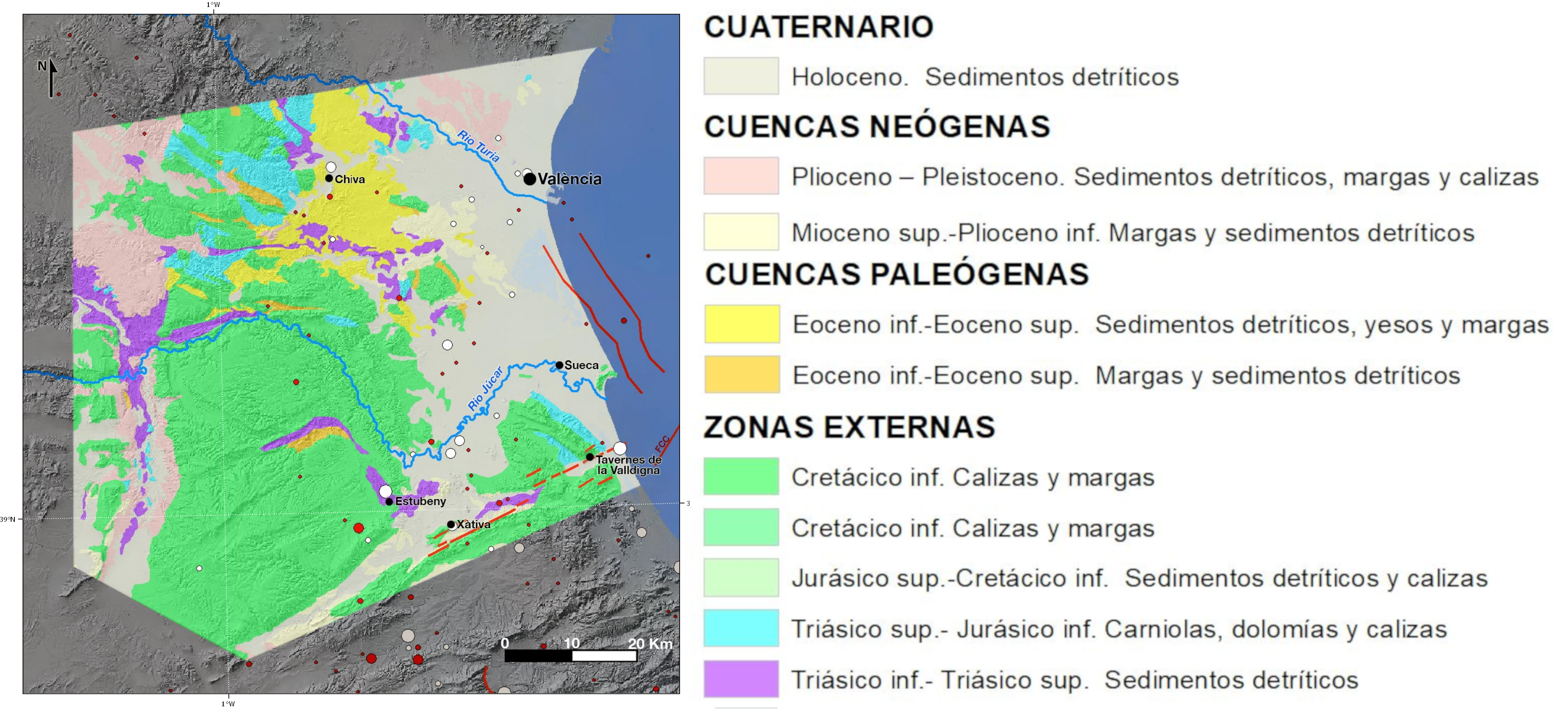
The historical and instrumental seismicity in this intra-plate mountain range is low except in its southeastern foothills, already in contact with the northeastern part of the Baetic mountain ranges, where there are important historical earthquakes catalogued that reach an intensity of IX in the province of Valencia such as that of 1396 in Tavernes de Valldigna and that of 1748 in Estubeny,
although no significant earthquakes have been recorded in the last 100 years, with the 1914 in Villanueva de Castellón and 1938 in Enguera of magnitudes slightly less than 5.0 being the largest.
In the rest of the Iberian mountain range we can highlight the earthquakes that occurred in the northeastern part, in La Rioja, such as that of 1817 in Prejano of maximum intensity of VII-VIII and 1929 in Turruncún of M5.2 and more to the south, and in the province of Zaragoza in 1912 in Zimballa of intensity VI-VII and 1953 in Used of M4.8. The areas of the Teruel and Jiloca graben, with active faults where important earthquakes have been studied in geological epochs do not have significant events in the catalogue of historical earthquakes.
In cases where it has been possible to study the nature of their earthquakes, this corresponds to an extensive regime in line with the influence in this area has the extension in the furrow of Valencia.
The Valencian geological sector corresponds to the SE part of the Iberian Mountain Range, which is called the Levantine Sector of the Castilian Branch of the Iberian Mountain Range. It borders to the south with the eastern foothills of the Betic Cordillera in its pre-Betic zone. Valencia is located in a wide morphological depression of complex tectonic origin. This depression, which receives the geographical name of Huerta de Valencia, extends between the sea and the foothills of the reliefs of Chiva and Buñol to the west.
Stratigraphically, the three Mesozoic periods, mainly from the Cretaceous, which form the elevated reliefs, emerge in the eastern sector. The general substratum is that of the detritic Triassic (mainly the Keuper) which outcrops in the lower parts of the hydrographic network. Above it, there is a transition formation towards the Lower Jurassic of Carniolas, Dolomites and limestones. Superimposed on this is a detritic and limestone formation attributed to the Upper Jurassic-Lower Cretaceous. Finally, on top of the previous series, limestones and marls from the Lower Cretaceous emerge massively, occupying 70% of the area. In the area of Valencia towards the south, these materials form the flank of a wide syncline of SE-WN direction, which is part of the "Iberian" structures of the south of Valencia.
The Paleogene basins are mainly Eocene composed of detritic sediments, gypsum and marl. Neogene sediments (Upper Miocene - Pliocene) of continental facies are characterized by their horizontal or slightly dipping disposition, they are discordant with the Paleogene or older series; they have a lithology of detritic materials with variable predominance of loams, clays or conglomerates.
The Quaternary is of special interest within the Valencia leaf because of its large surface area. As a whole, it is an extensive pre-coastal plain, occupied mostly by the Albufera and associated sediments and by the flooding silts of the Turia River. Towards the south, these grey silts of the Albufera continue, now semi-disappeared.
Holocene marine deposits can be recognized on today's beaches, which are made up of fine sands that form a narrow strip on the coast line.
At the SE end of the Valencia furrow there is a predominance of normal faults suggesting a homogeneous NE-SW extensional tectonic regime for this area. Like the Iberian mountain range, on the Valencian coast the deformation occurs outside the area of greatest alpine deformation. Regional seismotectonics seems to be controlled by the opening of the western Mediterranean basin rather than by plate convergence. The orientation of the NE-SW axes may be associated with extensional structures of the Teruel rift and the Valencia furrow. There is no evidence of the existence of a quaternary tectonics. The existence of recent earthquakes, the power of the Turia delta, which surpasses the Albufera, and the inexistence of staggered sea levels, in contrast to the levels of river terraces, lead us to suppose the existence of recent tectonic readjustments.
On the southern border of this zone, there are several faults in a SW-NE direction, such as that of Jumilla which passes through Xativa and a little to the south of Estubeny, an area with frequent seismicity.
| © Instituto Geográfico Nacional - C/ General Ibáñez de Ibero, 3. 28003 Madrid - España.
ign@fomento.es |